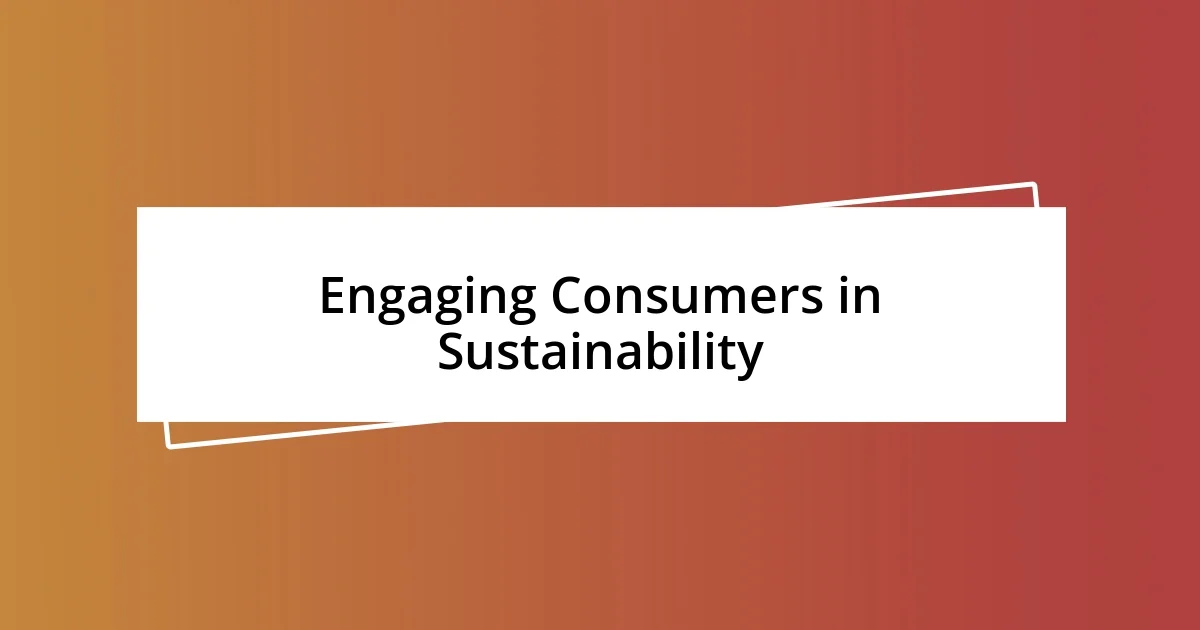Key takeaways:
- Eco-conscious brands prioritize sustainability, ethical sourcing, and community engagement, creating a lifestyle that resonates with consumers’ values.
- Transparency and storytelling foster trust and deeper connections, empowering consumers to make informed choices and feel part of a larger movement.
- Measuring impact through metrics like carbon footprint and community initiatives encourages consumer participation and highlights brands’ commitment to sustainability.

Understanding Eco-Conscious Brands
Eco-conscious brands are those companies that prioritize sustainability and environmental responsibility in their operations. They often focus on using ethically sourced materials and reducing waste, aiming to leave a minimal carbon footprint. When I first discovered the term “eco-conscious,” it struck me how brands could not only sell products but also promote a lifestyle that cares for our planet.
I remember shopping for a new jacket a few years back and coming across a brand that showcased its commitment to recycled materials and fair labor practices. It made me think about the impact of my choices as a consumer. Are we not all artists in the way we curate our lives? I found that supporting these brands not only brought me joy but also a sense of purpose, knowing my purchase contributed to a larger cause.
What’s fascinating is that eco-conscious brands often cultivate a community around their values. Their customers aren’t just buyers; they are advocates for change. This connection can be powerful. Have you ever felt that rush of excitement when you find a product that aligns with your values? That feeling reinforces my belief in the importance of supporting businesses that view sustainability as a pillar of their identity, rather than just a marketing strategy.

Criteria for Choosing Brands
When I’m evaluating eco-conscious brands, I consider their sourcing practices. For instance, I once stumbled upon a clothing line that emphasized organic cotton and fair trade certification. The moment I learned how much care they put into the entire supply chain, it solidified my decision to purchase from them. Knowing that the farmers were compensated fairly and environmentally-friendly practices were followed added immeasurable value to my buy.
Another vital criterion is transparency. I recall a moment when I encountered a beauty brand that openly shared its manufacturing process and ingredient sourcing online. Their candidness made me trust them, leading me to try their products with confidence. I realized that brands willing to expose their practices are often the ones that truly care about their impact.
Lastly, I pay attention to the brand’s commitment to community engagement. There’s something heartwarming about companies that give back, either through donations or volunteering. I supported a brand that partnered with local conservation efforts, and I felt like my contribution was now part of something bigger. It’s incredible to be part of a community effort—knowing that my purchase helps create positive changes in the world.
| Criterion | Description |
|---|---|
| Sourcing Practices | Focus on ethically sourced and sustainable materials. |
| Transparency | Open communication about manufacturing processes and ingredient origins. |
| Community Engagement | Involvement in charitable efforts and contributions to local initiatives. |

Building Partnerships with Brands
When I partner with eco-conscious brands, I embrace a narrative that goes beyond mere transactions. I recall a particular collaboration with a local skincare company that not only used biodegradable packaging but also sourced its ingredients from a community farm. The excitement of co-creating content that showcased their story felt rewarding. Each time I highlighted their mission on social media, I knew I was amplifying their voice while fostering a deeper connection with my followers. It affirmed my belief that partnerships can amplify the message of sustainability, creating a ripple effect that encourages more conscious consumer behavior.
- Collaborating with brands emphasizes mutual values.
- Sharing personal stories resonates deeply with audiences, fostering trust.
- Leveraging social platforms can enhance brand visibility and reach.
Building partnerships is an evolution of relationships where the brand’s ethos aligns with my own values. A few months ago, I teamed up with a jewelry brand committed to ocean conservation. The moment I learned that a percentage of each sale funded beach clean-ups, I felt a personal stake in the journey. Our conversations about sustainability became natural, and I discovered that such authentic interactions not only enrich my content but let me genuinely advocate for causes that matter. Being a part of this meaningful dialogue is a cherished aspect of my journey in supporting eco-conscious brands.

Promoting Sustainable Practices
Promoting sustainable practices is about more than just making a purchase; it’s about cultivating a lifestyle that aligns with my values. Last summer, I attended a pop-up market where vendors emphasized sustainability in every aspect of their business—from compostable packaging to eco-friendly production methods. I remember feeling inspired as I conversed with the creators. Their passion and dedication to reducing their ecological footprint communicated a message that stuck with me: conscious consumerism is incredibly powerful.
In my day-to-day life, I actively seek out brands that prioritize sustainability in their practices because it lets me contribute to a greater good. One time, I noticed a coffee shop that sourced its beans from fair-trade certified farms, and I struck up a conversation with the barista. She explained how their choice impacted not just the environment but also the farmers’ lives. It made me realize that even small decisions—like choosing where to buy my morning coffee—can have a meaningful impact.
I’ve also found that supporting transparent brands enhances my overall consumer experience. I vividly recall discovering a skincare line committed to sourcing ingredients ethically. They provided a map of their supply chain on their website, which felt like pulling back the curtain on the beauty industry. It got me thinking: how often do we see such transparency? This openness not only allowed me to make informed decisions but also instilled a sense of trust, making my support feel more intentional and impactful.

Supporting Local and Ethical Production
Supporting local and ethical production is a way for me to connect with artisans in my community and contribute to a more sustainable economy. Just last month, I visited a local textile workshop that handcrafts clothing using organic materials. As I watched the artisans weave their magic, I couldn’t help but feel a sense of pride knowing that my purchase directly supports their families and local culture. Isn’t it empowering to think that each garment carries a story and a slice of someone’s life?
I’ve also realized that shopping locally often means quality over quantity. For example, I purchased a handmade ceramic mug from a nearby studio, and the experience was fascinating. The artist shared her process, telling me about the sustainable practices she adopted to minimize waste. It hit me that by choosing local, I was not just getting a beautiful piece; I was supporting a philosophy that values craftsmanship and environmental stewardship. How often do we consider the journey our products take before they reach us?
Engaging with local brands goes beyond mere transactions; it’s an enriching experience. I remember joining a community event where small farmers showcased their goods. The enthusiasm and passion were palpable, and it reminded me of the importance of knowing where our food comes from. When we support such initiatives, we’re not just buying products; we’re investing in our neighborhoods and nurturing ecosystems. Isn’t that a lovely thought? Supporting local and ethical production has truly transformed how I shop and interact with my community.

Engaging Consumers in Sustainability
In my experience, engaging consumers in sustainability often hinges on storytelling. At a recent workshop, the speaker shared the backstory of a clothing line that started from a small, local initiative. As I listened, I felt a connection—I could almost visualize the journey from fabric to finished product, all while considering the environmental impact. Isn’t it fascinating how a compelling narrative can change our perception and make us more invested in sustainable brands?
I’ve noticed that interactive experiences create a deeper understanding of sustainability. For instance, I participated in a craft day organized by a local eco-friendly brand. As I learned to create my own beeswax wraps, I felt empowered and appreciated the effort behind each product. This hands-on involvement helped me realize how much effort goes into creating eco-friendly alternatives. Have you ever thought about how participating in such activities could cultivate a stronger sense of community?
Brands that prioritize sustainability often invite us into their processes. I remember attending an open-house event for a zero-waste grocery store. Walking through the aisles, I engaged with staff who shared tips on reducing plastic use and even showed me how to refill containers. It was illuminating and made me reconsider how I approached my own waste. Doesn’t it inspire you to be more mindful when you see others actively embracing eco-conscious choices?

Measuring Impact and Success
Measuring impact and success for eco-conscious brands requires a tangible approach. I recall a conversation with a founder of a sustainable fashion line who shared how they track their carbon footprint. It struck me that utilizing tools like life cycle assessments not only quantifies their environmental impact but tells a powerful story that resonates with consumers. Isn’t it remarkable how data can provide the clarity needed to drive positive change?
Another memorable experience was visiting a local coffee shop that proudly showcased their waste reduction statistics on the wall. Seeing their commitment to composting and recycling inspired me to be more conscious of my own habits. It made me wonder—how often do brands celebrate their successes in a way that encourages us to join in their journey? By transparently sharing metrics and milestones, brands foster trust and inspire fellow consumers to make more sustainable choices.
Success can also be measured through community engagement. I remember when a beauty brand I admire launched a campaign inviting customers to share their sustainable practices on social media. The outpouring of creativity and commitment from the community was exhilarating. This initiative not only highlighted the brand’s impact but also created a platform for dialogue that empowered others to join the movement. In what ways do you feel empowered to contribute to sustainability beyond your purchases?














